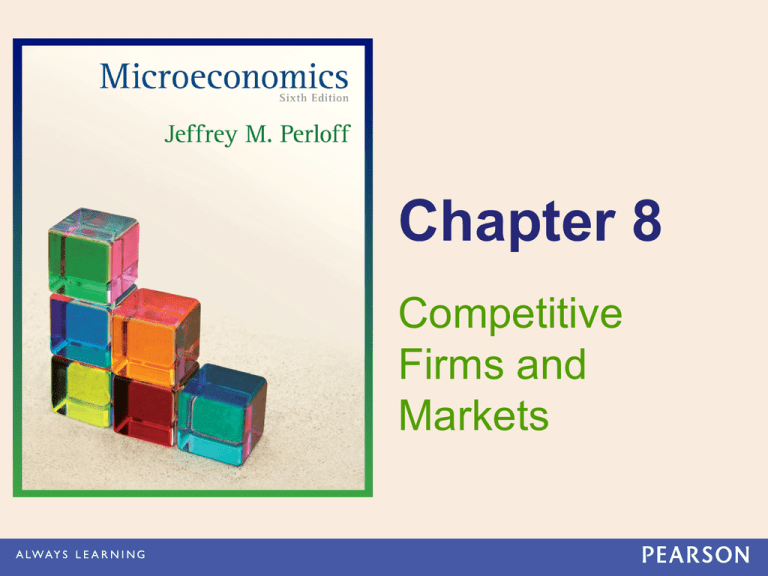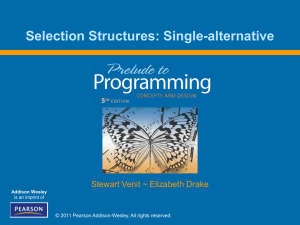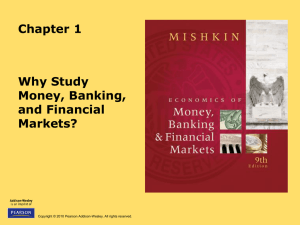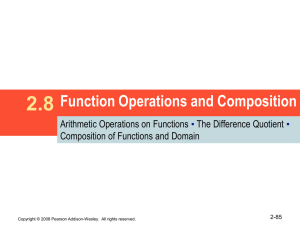
Chapter 8
Competitive
Firms and
Markets
Topics
• Perfect Competition.
• Profit Maximization.
• Competition in the Short Run.
• Competition in the Long Run.
8-2
Copyright © 2012 Pearson Addison-Wesley. All rights reserved.
Price Taking
• A market is competitive if each firm in the
market is a price taker.
w price taker - a firm that cannot significantly
affect the market price for its output or the
prices at which it buys its inputs.
w the price taker firm faces a demand curve
that is horizontal at the market price.
8-3
Copyright © 2012 Pearson Addison-Wesley. All rights reserved.
Why the Firm’s Demand Curve Is
Horizontal
•
•
•
•
•
8-4
Large number of buyers and sellers.
Firms sell identical products.
Buyers and sellers have full information.
Negligible transaction costs.
Firms freely enter and exit the market.
We call a market in which all these
conditions hold a perfectly competitive
market.
Copyright © 2012 Pearson Addison-Wesley. All rights reserved.
Deviations from Perfect Competition
• Many markets do not exhibit all
characteristics of perfect competition but
are still highly competitive.
• Competition – markets in which firms are
price takers even though the market does
not fully posses all the characteristics of
perfect competition.
8-5
Copyright © 2012 Pearson Addison-Wesley. All rights reserved.
Derivation of a Competitive Firm’s
Demand Curve
• Residual demand curve - the market
demand that is not met by other sellers at
any given price.
D’(p) = D(p) − So(p).
8-6
Copyright © 2012 Pearson Addison-Wesley. All rights reserved.
Figure 8.1 Residual Demand Curve
8-7
Copyright © 2012 Pearson Addison-Wesley. All rights reserved.
Why We Study Perfect Competition
• Many markets can be reasonabley
described as competitive (commodities
markets, stock exchanges, retail and
wholesale, construction).
• A perfectly competitive market has
desirable properties which are used as a
benchmark to compare real world markets
to.
8-8
Copyright © 2012 Pearson Addison-Wesley. All rights reserved.
Profit Maximization
• Economic profit - revenue minus
economic cost.
π = R − C.
w If profit is negative, π < 0, the firm makes a
loss.
w Economic cost includes both explicit and
implicit costs.
8-9
Copyright © 2012 Pearson Addison-Wesley. All rights reserved.
Two Steps to Maximizing Profit
• The firm’s profit function is:
π(q) = R(q) − C(q).
• To maximize its profit, any firm must answer two
questions:
w Output decision - If the firm produces, what output
level, q*, maximizes its profit or minimizes its loss?
w Shutdown decision - Is it more profitable to
produce q* or to shut down and produce no output?
8 - 10
Copyright © 2012 Pearson Addison-Wesley. All rights reserved.
Application: Breaking Even on
Christmas Trees
8 - 11
Copyright © 2012 Pearson Addison-Wesley. All rights reserved.
Output Rules
• Output Rule 1: The firm sets its output
where its profit is maximized.
• Output Rule 2: A firm sets its output
where its marginal profit is zero.
• Output Rule 3: A firm sets its output
where its marginal revenue equals its
marginal cost:
MR(q) = MC(q).
8 - 12
Copyright © 2012 Pearson Addison-Wesley. All rights reserved.
Output Rules (cont.)
• Marginal revenue (MR) - the change in
revenue a firm gets from selling one more
unit of output: MR =DR/Dq.
• Marginal profit - the change in profit a
firm gets from selling one more unit of
output.
w The change in the firm’s profit is:
Marginal profit(q) = MR(q) − MC(q).
8 - 13
Copyright © 2012 Pearson Addison-Wesley. All rights reserved.
Figure 8.2 Maximizing Profit
8 - 14
Copyright © 2012 Pearson Addison-Wesley. All rights reserved.
Shutdown Rule 1
• Shutdown Rule 1: The firm shuts down
only if it can reduce its loss by doing so.
• Example: R = $2,000, VC = $1,000, and F
= $3,000.
w This firm is making a short-run loss:
π = $2,000 − $1,000 − $3,000 = −$2,000.
w But if it were to shutdown, the loss would be:
π = −$3,000 = FC
8 - 15
Copyright © 2012 Pearson Addison-Wesley. All rights reserved.
Shutdown Rule 2
• Shutdown Rule 2: The firm shuts down
only if its revenue is less than its
avoidable cost.
8 - 16
Copyright © 2012 Pearson Addison-Wesley. All rights reserved.
Short-Run Output Decision
• Because a competitive firm’s marginal
revenue equals the market price:
MR = p
a profit-maximizing competitive firm
produces the amount of output at which
its marginal cost equals the market price:
MC(q) = p.
8 - 17
Copyright © 2012 Pearson Addison-Wesley. All rights reserved.
Cost, revenue, Thousand $
4,800
Figure 8.3 How
a Competitive
Firm Maximizes
Profit
(a)
which determines
the slope of the R
curve (=8)
Cost, C
Revenue
and more rapidly
with more output.
The cost curve, C, rises less
rapidly with low output….
100
0
–100"
q, Thousand metric tons of lime per
year
8 - 18
The demand for the firm is
horizontal….
p, $ per ton
(b)
8
0
Copyright © 2012 Pearson Addison-Wesley. All rights reserved.
p = MR
q, Thousand metric tons of lime per
year
Cost, revenue, Thousand $
Cost, C
4,800
2,272
1,846
Firm maximizes profit by
producing q = 284 …
100
0
–100
p*
284
q, Thousand metric tons of lime per
year
p, $ per ton
8 - 19
p(q)
p* = $426,000
(b)
MC
which is also the point at
which MC = p.
Revenue
Figure 8.3 How
a Competitive
Firm Maximizes
Profit
(a)
8
0
Copyright © 2012 Pearson Addison-Wesley. All rights reserved.
e
284
p = MR
q, Thousand metric tons of lime per
year
Cost, revenue, Thousand $
Cost, C
4,800
Revenue
Figure 8.3 How
a Competitive
Firm Maximizes
Profit
(a)
2,272
p*
1,846
840
426
100
0
–100
10
284
q, Thousand metric tons of lime per
year
MC
p, $ per ton
(b)
140
p(q)
p* = $426,000
AC
8
e
p = MR
p* = $426,000
6
0
6.50
8 - 20
Copyright © 2012 Pearson Addison-Wesley. All rights reserved.
140
284
q, Thousand metric tons of lime per
year
Cost, r evenue, Thousand $
Cost, C
4,800
Revenue
Figure 8.3
How a
Competitive
Firm
Maximizes
Profit
(a)
2,272
p*
1,846
840
426
100
0
–100
10
284
q, Thousand metric tons of lime per
year
MC
What if the market
price fell below $6?
p, $ per ton
(b)
140
p(q)
p* = $426,000
AC
8
e
p = MR
p* = $426,000
6
0
6.50
8 - 21
Copyright © 2012 Pearson Addison-Wesley. All rights reserved.
140
284
q, Thousand metric tons of lime per
year
Solved Problem 8.1
• If a specific tax of τ is collected from only
one competitive firm, how should that firm
change its output level to maximize its
profit, and how does its maximum profit
change?
8 - 22
Copyright © 2012 Pearson Addison-Wesley. All rights reserved.
Solved Problem 8.1
8 - 23
Copyright © 2012 Pearson Addison-Wesley. All rights reserved.
Short-Run Shutdown Decision
•
The firm can gain by shutting down only if its
revenue is less than its short-run variable cost:
pq < VC
w In average terms:
p < AVC(q).
A competitive firm shuts down if the market price
is less than the minimum of its short-run
average variable cost curve.
8 - 24
Copyright © 2012 Pearson Addison-Wesley. All rights reserved.
Figure 8.4 The Short-Run Shutdown Decision
8 - 25
Copyright © 2012 Pearson Addison-Wesley. All rights reserved.
Solved Problem 8.2
• A competitive firm’s bookkeeper, upon
reviewing the firm’s books, finds that the
firm spent twice as much on its plant, a
fixed cost, as the firm’s manager had
previously thought. Should the manager
change the output level because of this
new information? How does this new
information affect profit?
8 - 26
Copyright © 2012 Pearson Addison-Wesley. All rights reserved.
Solved Problem 8.2
• Answer:
w Show that a change in fixed costs does not
affect the firm’s decisions.
w Show that the change in how the bookkeeper
measures fixed costs does not affect
economic profit.
8 - 27
Copyright © 2012 Pearson Addison-Wesley. All rights reserved.
Short-Run Firm Supply Curve
• If the price falls below the firm’s minimum
average variable cost the firm shuts down.
w Thus:
the competitive firm’s short-run supply curve is
its marginal cost curve above its minimum
average variable cost.
8 - 28
Copyright © 2012 Pearson Addison-Wesley. All rights reserved.
Figure 8.5 How the Profit-Maximizing
Quantity Varies with Price
8 - 29
Copyright © 2012 Pearson Addison-Wesley. All rights reserved.
Factor Prices and the Short-Run Firm
Supply Curve
• An increase in factor prices causes the
production costs of a firm to rise, shifting
the firm’s supply curve to the left.
8 - 30
Copyright © 2012 Pearson Addison-Wesley. All rights reserved.
Figure 8.6 Effect of an Increase in the Cost of
Materials on the Vegetable Oil Supply Curve
8 - 31
Copyright © 2012 Pearson Addison-Wesley. All rights reserved.
Short-Run Market Supply Curve
• In the short run, the maximum number of
firms in a market, n, is fixed.
• If all the firms in a competitive market are
identical, each firm’s supply curve is
identical, so the market supply at any
price is n times the supply of an individual
firm.
8 - 32
Copyright © 2012 Pearson Addison-Wesley. All rights reserved.
Short-Run Market Supply with Identical
Firms
• As the number of firms grows very large,
the market supply curve approaches a
horizontal line at the minimum point of the
AVC curve.
• Thus,
the more identical firms producing at a
given price, the flatter (more elastic) the
short-run market supply curve at that
price.
8 - 33
Copyright © 2012 Pearson Addison-Wesley. All rights reserved.
Figure 8.7 Short-Run Market Supply
with Five Identical Lime Firms
8 - 34
Copyright © 2012 Pearson Addison-Wesley. All rights reserved.
Figure 8.8 Short-Run Market Supply
with Two Different Lime Firms
8 - 35
Copyright © 2012 Pearson Addison-Wesley. All rights reserved.
Figure 8.9 Short-Run Competitive
Equilibrium in the Lime Market
8
e1
8 - 36
5
0
7
B
S
D1
E1
D2
6.20
C
8
AC
A
S1
7
6.97
(b) Ma rket
p, $ per ton
p, $ per ton
(a) Fir m
AVC
e2
q2 = 50
q,
Thousand met
r
ic tons
of lime per
year
q1 = 215
Copyright © 2012 Pearson Addison-Wesley. All rights reserved.
5
0
E2
Q2 = 250
Q1 = 1,075
Q, Thousand met ric tons
of lime per year
Solved Problem 8.3
• What is the effect on the short-run
equilibrium of a specific tax of τ per unit
that is collected from all n firms in a
market? What is the incidence of the tax?
8 - 37
Copyright © 2012 Pearson Addison-Wesley. All rights reserved.
Solved Problem 8.3
8 - 38
Copyright © 2012 Pearson Addison-Wesley. All rights reserved.
Long-Run Output Decision
• The firm chooses the quantity that
maximizes its profit using the same rules
as in the short run.
• The firm picks the quantity that maximizes
long-run profit, the difference between
revenue and long-run cost.
8 - 39
Copyright © 2012 Pearson Addison-Wesley. All rights reserved.
Long-Run Shutdown Decision
• In the long run, the firm shuts down if it
would make an economic loss by
operating.
8 - 40
Copyright © 2012 Pearson Addison-Wesley. All rights reserved.
Long-Run Firm Supply Curve
• A firm’s long-run supply curve is its longrun marginal cost curve above the
minimum of its long-run average cost
curve.
w The firm is free to choose its capital in the
long run, so the firm’s long-run supply curve
may differ substantially from its short-run
supply curve.
8 - 41
Copyright © 2012 Pearson Addison-Wesley. All rights reserved.
Figure 8.10 The Short-Run and
Long-Run Supply Curves
8 - 42
Copyright © 2012 Pearson Addison-Wesley. All rights reserved.
Long-Run Market Supply Curve
• The competitive market supply curve is the
horizontal sum of the supply curves of the
individual firms in both the short run and the
long run.
• But, in the long run, firms can enter or leave the
market.
• Thus, before we can obtain the long-run market
supply curve, we need to determine how many
firms are in the market at each possible market
price.
8 - 43
Copyright © 2012 Pearson Addison-Wesley. All rights reserved.
Role of Entry and Exit
• In a market with free entry and exit:
w A firm enters the market if it can make a longrun profit, π > 0.
w A firm exits the market to avoid a long-run
loss, π < 0.
w If firms in a market are making zero long-run
profit, they stay in the market.
8 - 44
Copyright © 2012 Pearson Addison-Wesley. All rights reserved.
Long-Run Market Supply with Identical
Firms and Free Entry
• The long-run market supply curve is flat at
the minimum long-run average cost if
firms can freely enter and exit the market,
an unlimited number of firms have
identical costs, and input prices are
constant.
8 - 45
Copyright © 2012 Pearson Addison-Wesley. All rights reserved.
Figure 8.11 Long-Run Firm and Market
Supply with Identical Vegetable Oil Firms
8 - 46
Copyright © 2012 Pearson Addison-Wesley. All rights reserved.
Long-Run Market Supply When Entry Is
Limited
• If the number of firms in a market is
limited in the long run, the market supply
curve slopes upward.
8 - 47
Copyright © 2012 Pearson Addison-Wesley. All rights reserved.
Long-Run Market Supply When Firms
Differ
• Firms with relatively low minimum longrun average costs are willing to enter the
market at lower prices than others,
resulting in an upward-sloping long-run
market supply curve.
8 - 48
Copyright © 2012 Pearson Addison-Wesley. All rights reserved.
Application Upward-Sloping Long-Run
Supply Curve for Cotton
8 - 49
Copyright © 2012 Pearson Addison-Wesley. All rights reserved.
Long-Run Market Supply When Input
Prices Vary with Output
• A third reason why market supply curves
may slope is nonconstant input prices.
• In markets in which factor prices rise or
fall when output increases, the long-run
supply curve slopes even if firms have
identical costs and can freely enter and
exit.
8 - 50
Copyright © 2012 Pearson Addison-Wesley. All rights reserved.
Increasing and Constant-Cost Markets
• Increasing-cost market – a market in
which input prices rise with output.
• Constant-cost market – a market in
which input prices remain constant as
output increases.
• The long-run supply curve is upward
sloping in an increasing-cost market and
flat in a constant-cost market.
8 - 51
Copyright © 2012 Pearson Addison-Wesley. All rights reserved.
Figure 8.12 Long-Run Market Supply
in an Increasing-Cost Market
8 - 52
Copyright © 2012 Pearson Addison-Wesley. All rights reserved.
Decreasing-Cost Markets
• Decreasing-cost markets - a market in
which as market output rises, at least
some factor prices fall.
w As a result,
in a decreasing-cost market, the long-run
market supply curve is downward sloping.
8 - 53
Copyright © 2012 Pearson Addison-Wesley. All rights reserved.
Figure 8.13 Long-Run Market Supply
in a Decreasing-Cost Market
8 - 54
Copyright © 2012 Pearson Addison-Wesley. All rights reserved.
Long-Run Market Supply Curve with
Trade
• Residual supply curve - the quantity that
the market supplies that is not consumed
by other demanders at any given price:
S’(p) = S(p) − Do(p).
8 - 55
Copyright © 2012 Pearson Addison-Wesley. All rights reserved.
Figure 8.14 Excess or Residual Supply
Curve
8 - 56
Copyright © 2012 Pearson Addison-Wesley. All rights reserved.
Solved Problem 8.4
• In the short run, what happens to the
competitive market price of gasoline if the
demand curve in a state shifts to the right
as more people move to the state or start
driving gas-hogging SUVs? In your
answer, distinguish between areas in
which regular gasoline is sold and
jurisdictions that require special blends.
8 - 57
Copyright © 2012 Pearson Addison-Wesley. All rights reserved.
Solved Problem 8.4
8 - 58
Copyright © 2012 Pearson Addison-Wesley. All rights reserved.
Figure 8.15 The Short-Run and
Long-Run Equilibria for Vegetable Oil
If the demand curve is D1,
in the short run…
…in the long run…
8 - 59
Copyright © 2012 Pearson Addison-Wesley. All rights reserved.
If the demand curve is D2,
in the short run
…in the long run…
Figure 8.16 Effects of an Increase in
a Lump-Sum Cost
8 - 60
Copyright © 2012 Pearson Addison-Wesley. All rights reserved.








